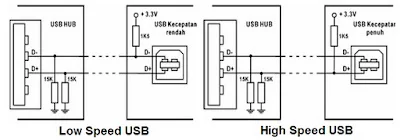USB cable signals
USB cable consists of 4 wires plus a conductor wire wrapping, such as the protectors are usually found in the audio cable. Cable number 1 is used to channel resources to the voltage of 5 volts, if necessary USB devices may draw power from this line and should not exceed 100 mA. Computer equipped with USB capability, is required to provide power at 100 mA for this purpose. USB devices that require more power than the aforementioned provisions, must provide their own resources for the purposes work equipment.
 |
| The USB cable signals |
Number 4 is the ground cable as a back channel source voltage of 5 volts. Cable number 2 and number 3 is used for signal transmission. No. 2 cable and cable called D-3 numbers called D, the voltage on the two channels is changed between 0 Volt and 3.3 Volt. Digital signal is sent through the two channels are said to be 'difference signal', which means that the signal digital '0 'or '1' is not declared to the magnitude of the voltage on the channel to the ground, as well as digital signals used in the IC TTL (transistor Transitor Logic) or the RS232 channel.
Digital signal is expressed by the voltage difference between the two cables. If the voltage on the D channel is higher than the voltage at D-channel, then the information transmitted digital signal is '1 ', otherwise the digital signal '0' is expressed by the voltage at D <voltage at D-. To distinguish the speed of data transmission, the channel USB devices attached to the 3.3 Volt prisoners in different ways, as shown in Fig.
At low speed USB devices, the D-channel to 3.3 Volt dipasangan custody, or in the absence of information transmission, the channel is in state '0 '. For full speed USB device, such resistance is connected to the D channel, so that in the absence of data transmission channels are in state '1 '.
.jpg)